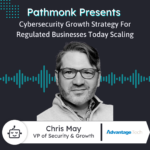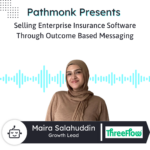SaaS
Introduction
Bobby Martin’s is co-founder and CEO of Vertical IQ, a leading provider of industry research insight for banks, CPAs, consultants, and advisors. Bobby is also an active angel investor in startups and serves as an active board member with several innovative start-ups. He is also author of The Hockey Stick Principles about 4 stages to entrepreneurial success. Today we speak about how Bobby has always adapted his & his teams skills to the current challenge on hand. We also deep dive into the right Call to Action for their website conversions…
See an abstract of the interview on SaaS demos…
Pathmonk: What role would the website be playing in the overall mix of finding and getting new customers?
Bobby Martin: Yeah, great point.The website has lots of interesting information on it.We have a blog, we have lots of information about how the product can be used for all the things you could typically see. We’re also pretty active on LinkedIn and that type of thing. The freemium though I would say is the main draw of the website and we want to keep it real simple and easy to use, so that people get there and know what to do. So that’s what draws the most people. However we recently hired a guy named Dave Buffalo who is our new chief marketing officer. David is doing a great job of taking our marketing to another level.
Pathmonk: Interesting because I saw on the website you can request a demo or you can get started for free. I had that conversation with a lot of SaaS and software founders. Like how do you look at those two different flows of going through a demo or starting a trial?
Bobby Martin: Yeah. Yeah. Actually that’s a really good question. I think one of the things David will do is to make us even more intuitive and clear over somebody comes to our website how do they know exactly what they’re supposed to do? Which is your big part of your question. It’s a natural path for me to sign up for freemium or should I sign up for a demo? We don’t want to confuse people and maybe we are now, however, I will say a demonstration is more likely if you’re providing vertical, like you’d have multiple people within your organization. If your head of sales operations or VP of marketing, you’re likely to take a demonstration because you’re trying to solve a problem. That’s bigger. Well if you’re just a casual user who’s heard about vertical IQ, then you’re likely to use the freemium. Yeah, so that kind of, that’s how people are intuitively supposed to know what to do. It makes total sense. I mean it is, it’s interesting because a lot of companies we’ve been talking to it was the same situation. Like you have, bigger accounts coming to the page and you, I want to qualify them and that comes through to demo what others start a trial because they’re individual users. So it’s not an uncommon challenge. That’s right. We could improve that for sure. We could probably use Pathmonk to up our game.
Pathmonk: What are metrics that you would care about on your website? Is that something that you would be looking at to steer and drive the business?
Bobby Martin: Yeah, so we’re getting better at that. I mean, we certainly look at all the typical metrics in terms of number of individual users that visit the site, their activity on the site, what they’re doing on the site. You might’ve heard of Pendo, a company that enables you to sorta see the activity and the pathway, if you will, of what people are doing.We subscribed to Pendo, which provides a lot of those metrics and also helps educate people as they’re using our particular tool, their paid use, of the tool. We certainly look at conversion rates, for example, the percentage of freemium that become subscribers. The percentage of freemium who come, who use it frequently versus casually. And you know, metrics like that.To tell you the truth, vertical IQ, it’s always been in my predecessor companies first research, a company before that just sold a dun and Bradstreet. The average subscription is about, the range of $15,000 a year. We’ve always been a sales centric company. In other words, we have enterprise salespeople and we make most of our revenue from sales. However we’re becoming better or more and more active with digital sales, digital marketing and that kind of thing. It’s a place we really need to improve a lot.
Pathmonk: Very interesting. Especially that you steering that move now it sounds like an inbound strategy next to a sales strategy. Maybe you can tell me, if you remember back those first 10 customers, how did you get them?
Bobby Martin: Yeah, sure. So, I should preface the that particular answer with, I started at which I mentioned first research in 1999 and then I started vertical IQ in 2011 there’s somewhat similar businesses to both industry research companies.The more interesting story is the first research when, because there was no market for what I was doing, it was a brand new idea, which is, the average person needs industry research right at their fingertips for an affordable price.And that was my idea.To get the first 10 customers was slow going and I had to yet the first 10 customers myself, very manual.When I say manual, I mean begging people to pay me six or $700 to access our entire database, which was, right now we have more than 500 industries. Back then we had like 30 industries and that was it.It was hit and miss on whether we covered the industries they were interested in the first place.It was, but we had very low cost structure.I mean, I was spending a couple of grand a month if that.I had, I was very fortunate from that vantage point.I didn’t have a big nut to cover, but to tell you how I got those customers, I’d knocked on a ton of doors.You know, it was the entrepreneurial grind.As I say in my book, the hockey stick principles, there’s four stages.The stage I was in is called the blade years, which is when revenues love and growth 2as low. And it was three years of shogon. We finally, well he hit what I call the growth inflection point. People started calling us. I was like, wow, sales cycle went from one year to three months or two months.
Pathmonk: What do you think changed?
Bobby Martin: Yeah, that’s actually a really good question. I think that, well I did think the way I was getting the first 10 customers was really manual, but the way I did that is selling more than the product itself.I would sell myself, for example, I would say if you sign up for vertical IQ, I’m sorry, first research at that time, then I will be your insides tr sales trainer.I would teach her people personally how to become great at pre-call preparation.I see this all the time for those first few customers on getting them by selling not only the product but also the founder, him or herself, giving free something consulting if you will, to the businesses.
(…)











